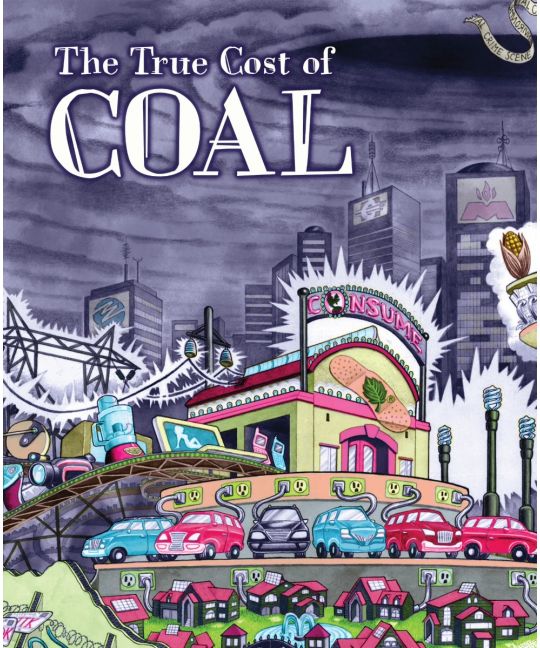True Cost of Coal – Interview with Beehive Design Collective members
We reached out to the creators of the True Cost of Coal rhyming narrative & activity book to learn more about the beautiful book and why they decided to make it.
What is the Beehive Design Collective?
The Beehive Collective is a collective of artists, activists, educators and organizers who work as word-to-image translators of complex global stories, shared with us through conversations with affected communities. We then share those images and stories with many communities in the form of graphic storytelling.
The True Cost of Coal: A Companion Rhyming Book is described as “a narrative companion to the True Cost of Coal graphic, created for a younger audience.” Can you start by telling us about the True Cost of Coal graphic: what is it and how did it come about?
Saku Bee: For a long time, Bees have talked about wanting to transform one of our posters into a colouring book aimed at younger audiences. We decided that “The True Cost of Coal” poster was the prime candidate as its single narrative format makes it easier for younger audiences to understand than the more analytic posters that go into detail about the dynamics of globalization, like “MesoAmérica Resiste”. As a parent to a toddler, I was reading rhyming storybooks to our kid sometimes 10 times a day, and I got the cadence stuck in my head. That’s when I started to write the narrative of the True Cost of Coal to the cadence of a Dr. Seuss story. My partner, who is also a bee and a hiphop artist jumped in to help co-author. So, whenever I would get stuck in the rhyme, he was able to write the next many lines. After the first draft was done, we were able to send it to educators and ask for their edits and suggestions.
Can you describe this companion rhyming book for us a little bit?
Well, the rhyme itself has a cadence that is fun to read – no matter your age – and it takes you from the creation of coal, through the first peoples, colonization, industrialization, mechanization (the replacement of workers by machines), resistance, and the future that people in Appalachia hope for.
The final section is a colouring and activity book, that goes deeper into the terms and concepts of the main text. We talk about terms like colonization or even unions assuming the reader understands what these things are, which isn’t true for a younger audience… so this section explains these things and also has interactive activities so that the reader can think more deeply about these issues.
Why did you decide to create a companion book for younger audiences? What age range is it aimed at?
The age range is 9-99, as we think that adults will love this book as much as younger people. Rhyming books are typically marketed at 3-6 year olds, but we think that the topics might be too mature for an audience that young.
The book covers a lot of complicated and painful ground, from colonization and the Trail of Tears, to the labour movement and the Battle of Blair Mountain. Why do you think it’s important to make these ideas and histories accessible to younger people and what are some things you kept in mind when thinking about how to do that effectively and responsibly?
Younger audiences need more resources that teach about the history of colonialism, labour struggle, and grassroots resistance in an accessible way. Parents and teachers we know are hungry for materials they can use to start these important conversations too. Communicating responsibly with youth about this history can be challenging, so we use nature metaphors, and images that focus on the fighting spirit of the living rather than on sensationalizing the tragedies or using the violence and death for shock value. We avoid creating narratives where any child will feel shame or guilt, but rather be inspired to fight for a better future. Youth are rising up against the climate catastrophe in inspiring ways worldwide, and we hope this book can be used to show how the climate chaos of today was paved with oppression and fought with fierce resistance. This was not the case of mere short-sightedness, but the result of a power dynamic that undermined the ability of local communities to determine their own fates. Once we understand this as historic fact, we can see ourselves as part of a struggle that has existed for generations.
Where can people buy a copy of The True Cost of Coal: A Companion Rhyming Book?
Through wonderful distributors like Kersplebedeb! Get your copy here.
If you are a bookstore, distro, or educational institution who would like to order in bulk, please email us at truecostofcoalbook@gmail.com or visit our website at truecostofcoalbook.com

Leave a Reply